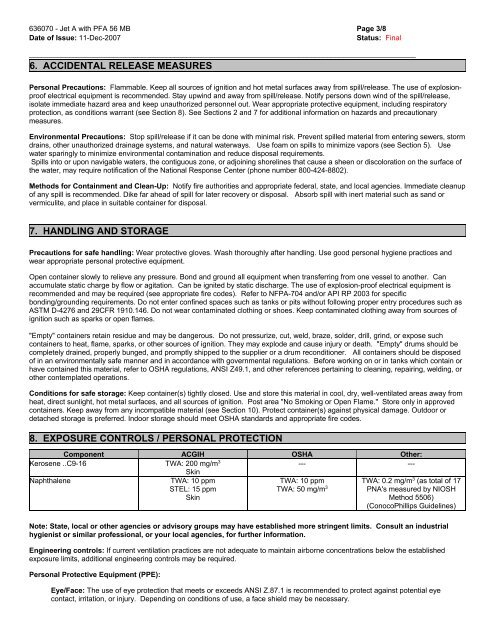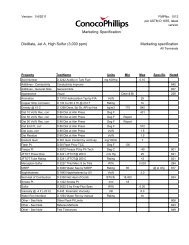Jet A with PFA 56 MB - Phillips 66 Aviation
Jet A with PFA 56 MB - Phillips 66 Aviation
Jet A with PFA 56 MB - Phillips 66 Aviation
You also want an ePaper? Increase the reach of your titles
YUMPU automatically turns print PDFs into web optimized ePapers that Google loves.
636070 - <strong>Jet</strong> A <strong>with</strong> <strong>PFA</strong> <strong>56</strong> <strong>MB</strong><br />
Date of Issue: 11-Dec-2007<br />
Page 3/8<br />
Status: Final<br />
________________________________________________________________________________________________<br />
6. ACCIDENTAL RELEASE MEASURES<br />
Personal Precautions: Flammable. Keep all sources of ignition and hot metal surfaces away from spill/release. The use of explosionproof<br />
electrical equipment is recommended. Stay upwind and away from spill/release. Notify persons down wind of the spill/release,<br />
isolate immediate hazard area and keep unauthorized personnel out. Wear appropriate protective equipment, including respiratory<br />
protection, as conditions warrant (see Section 8). See Sections 2 and 7 for additional information on hazards and precautionary<br />
measures.<br />
Environmental Precautions: Stop spill/release if it can be done <strong>with</strong> minimal risk. Prevent spilled material from entering sewers, storm<br />
drains, other unauthorized drainage systems, and natural waterways. Use foam on spills to minimize vapors (see Section 5). Use<br />
water sparingly to minimize environmental contamination and reduce disposal requirements.<br />
Spills into or upon navigable waters, the contiguous zone, or adjoining shorelines that cause a sheen or discoloration on the surface of<br />
the water, may require notification of the National Response Center (phone number 800-424-8802).<br />
Methods for Containment and Clean-Up: Notify fire authorities and appropriate federal, state, and local agencies. Immediate cleanup<br />
of any spill is recommended. Dike far ahead of spill for later recovery or disposal. Absorb spill <strong>with</strong> inert material such as sand or<br />
vermiculite, and place in suitable container for disposal.<br />
7. HANDLING AND STORAGE<br />
Precautions for safe handling: Wear protective gloves. Wash thoroughly after handling. Use good personal hygiene practices and<br />
wear appropriate personal protective equipment.<br />
Open container slowly to relieve any pressure. Bond and ground all equipment when transferring from one vessel to another. Can<br />
accumulate static charge by flow or agitation. Can be ignited by static discharge. The use of explosion-proof electrical equipment is<br />
recommended and may be required (see appropriate fire codes). Refer to NFPA-704 and/or API RP 2003 for specific<br />
bonding/grounding requirements. Do not enter confined spaces such as tanks or pits <strong>with</strong>out following proper entry procedures such as<br />
ASTM D-4276 and 29CFR 1910.146. Do not wear contaminated clothing or shoes. Keep contaminated clothing away from sources of<br />
ignition such as sparks or open flames.<br />
"Empty" containers retain residue and may be dangerous. Do not pressurize, cut, weld, braze, solder, drill, grind, or expose such<br />
containers to heat, flame, sparks, or other sources of ignition. They may explode and cause injury or death. "Empty" drums should be<br />
completely drained, properly bunged, and promptly shipped to the supplier or a drum reconditioner. All containers should be disposed<br />
of in an environmentally safe manner and in accordance <strong>with</strong> governmental regulations. Before working on or in tanks which contain or<br />
have contained this material, refer to OSHA regulations, ANSI Z49.1, and other references pertaining to cleaning, repairing, welding, or<br />
other contemplated operations.<br />
Conditions for safe storage: Keep container(s) tightly closed. Use and store this material in cool, dry, well-ventilated areas away from<br />
heat, direct sunlight, hot metal surfaces, and all sources of ignition. Post area "No Smoking or Open Flame." Store only in approved<br />
containers. Keep away from any incompatible material (see Section 10). Protect container(s) against physical damage. Outdoor or<br />
detached storage is preferred. Indoor storage should meet OSHA standards and appropriate fire codes.<br />
8. EXPOSURE CONTROLS / PERSONAL PROTECTION<br />
Component ACGIH OSHA Other:<br />
Kerosene ..C9-16 TWA: 200 mg/m 3<br />
--- ---<br />
Skin<br />
Naphthalene<br />
TWA: 10 ppm<br />
STEL: 15 ppm<br />
Skin<br />
TWA: 10 ppm<br />
TWA: 50 mg/m 3 TWA: 0.2 mg/m 3 (as total of 17<br />
PNA's measured by NIOSH<br />
Method 5506)<br />
(Conoco<strong>Phillips</strong> Guidelines)<br />
Note: State, local or other agencies or advisory groups may have established more stringent limits. Consult an industrial<br />
hygienist or similar professional, or your local agencies, for further information.<br />
Engineering controls: If current ventilation practices are not adequate to maintain airborne concentrations below the established<br />
exposure limits, additional engineering controls may be required.<br />
Personal Protective Equipment (PPE):<br />
Eye/Face: The use of eye protection that meets or exceeds ANSI Z.87.1 is recommended to protect against potential eye<br />
contact, irritation, or injury. Depending on conditions of use, a face shield may be necessary.




